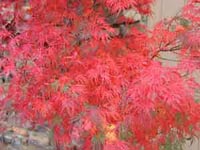Resource Library
Plant of the Week: Maple, Japanese
The University of Arkansas System Division of Agriculture does not promote, support or recommend plants featured in "Plant of the Week." Please consult your local Extension office for plants suitable for your region.
Plant of the Week
Japanese Maple
Latin: Acer palmatum dissectum

It’s easy to become complacent with the glories of nature until reminded of her by the subtle sledgehammer of fall color. This year, the display on the mountainsides and streets of northwest Arkansas have been among the most spectacular I recall.
But to really appreciate the autumnal transition to the fullest extent it must be observed up close. A Japanese maple, Acer palmatum dissectum ‘Seiryu’, growing near my patio allows me to follow this seasonal transition from the comfort of my lawn chair.
Seiryu Japanese maple belongs to the "Dissectum" group of cultivars but, instead of the more common wide-spreading, bush-like habit of most selections in this group, Seiryu grows upright like any self respecting tree. For a Japanese maple it’s fairly fast growing, putting on a foot or more of growth a year but avoiding the twigginess of some selections. Its mature height will probably be in the 15- to 20-foot range with a spread of 12 feet.
As a member of the Dissectum group, Seiryu has lacy green leaves dissected into seven segments, each cut all the way to the petiole. In summer, the tree has a light green color and reminds me of green lace curtains. In late autumn, the leaves turn to an expectant green, then to a muddy orange and finally a brilliant red, all within a 48-hour period.
This is the last tree to color in my landscape, usually turning around Nov. 10 and lasting in full glory for about five days. Should a hard freeze hit too early, no color will develop.
Predicting fall color displays in advance is import to the Chamber of Commerce of any city expecting a boost in tourism during the fall season, but it is hardly an exact science. Having read a number of these predictions over the years, I can’t recall a single one that said, "This is going to be a bum year - stay at home." Go figure! Like the quality of a vintage wine, fall color depends on the weather. The best displays occur when we have wet conditions during the early part of the growing season followed by late summer drought.
The early season moisture helps ensure abundant growth with a good load of leaves. The late season stress puts on the brakes to growth and helps insure the leaves will be predisposed to turning when fall arrives. Too much drought will cause leaf drop and burning, something the Chamber of Commerce really hates.
The environmental trigger that initiates the change in leaf color is the shortening length of the days, but the magnitude of color development is intensified by temperature and sunlight conditions. Ideal conditions are clear, bright days warming to room temperature during the day and then dropping to almost freezing at night. Rain and wind during the display put a quick end to the autumnal displays.
If Japanese maples produced no fall color display, I would still want to use them in the landscape because of their elegance and beauty. I find they do best when grown in an area with some shade, such as on the east side of a building where protected from the hot afternoon sun.
Mine are planted under the high canopy of oak trees where they do well, but their growth is no doubt slowed by competition for water. The Dissectum group of cultivars, with their thinner leaves, is more likely to suffer sunburn than selections with the normal leaf shape.
Of the several trees I have, not surprisingly, the fastest and most lush growth occurs in fertile, moist soils. But the trees planted in my rocky clay are prospering as long as they are watered during the summer.
By: Gerald Klingaman, retired
Extension Horticulturist - Ornamentals
Extension News - November 15, 2002
The University of Arkansas System Division of Agriculture does not maintain lists of retail outlets where these plants can be purchased. Please check your local nursery or other retail outlets to ask about the availability of these plants for your growing area.